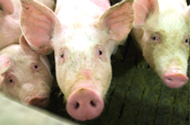Mycotoxins causing huge economic losses in pig herds

Mycotoxins could be causing huge economic losses in pig herds, particularly when 25% of the world’s grain is contaminated, stressed Quality Meat Scotland’s Allan Ward and Scottish Agriculture College Jill Thomson at SAC’s pig research workshop.
There are two main mycotoxins in wheat causing significant problems in pig herds – zea
ralenone (Zon) and deoxynivalenol (Don) – and both cause symptoms that may not at first be indicative of mycotoxins, said Dr Thomson.
“Zon causes oestrogenic effects such as swollen vulva and vaginal and rectal prolapses as well as obscure effects such as infertility, returns and anoestrus as well as boar infertility.”
Don on the other hand has more of an effect in growing pigs and has a tendency to reduce feed intake and growth rates and result in poorer feed conversion ratios. Pigs affected by Don are also likely to be immuno-compromised and are more susceptible to rectal and vaginal prolapses.
“But Don also affects sows and can have feed effects, cause delayed puberty, infertility, still births and small and weak piglets,” added Dr Thomson.
German feeding study
“In fact a German study feeding low mycotoxin and high mycotoxin diets to groups of pigs found those on the low mycotoxin diet ate 1kg/head/day more than the high mycotoxin diet group, which obviously affected growth weight and costs of production,” she said.
But sow mycotoxin consumption during gestation could also affect piglets, added Dr Thomson. “Mycotoxins can cross the placenta which can reduce piglet feeding behaviour. Sows have also been found to store mycotoxins in body fat which can then be excreted in the milk when fat is mobilised for milk production, and as a result can cause vomiting in piglets.”
Studies by SAC and QMS have also found mycotoxins can be detected in blood and bile with mycotoxins remaining in bile for 7-10 days. “We also found from our studies that pigs with rectal prolapses all had high mycotoxins values.”
Limit the effects
But there are things that farmers can do to limit the effects of mycotoxins in their herd, said Ward. “You don’t always know feed is contaminated with mycotoxins as the feed doesn’t always have to look mouldy. So looking out for the symptoms, using mycotoxin binders, properly drying grain and good bin hygiene are just some of the things that limit the effect of mycotoxins.”
Source: Farmers Weekly Interactive











